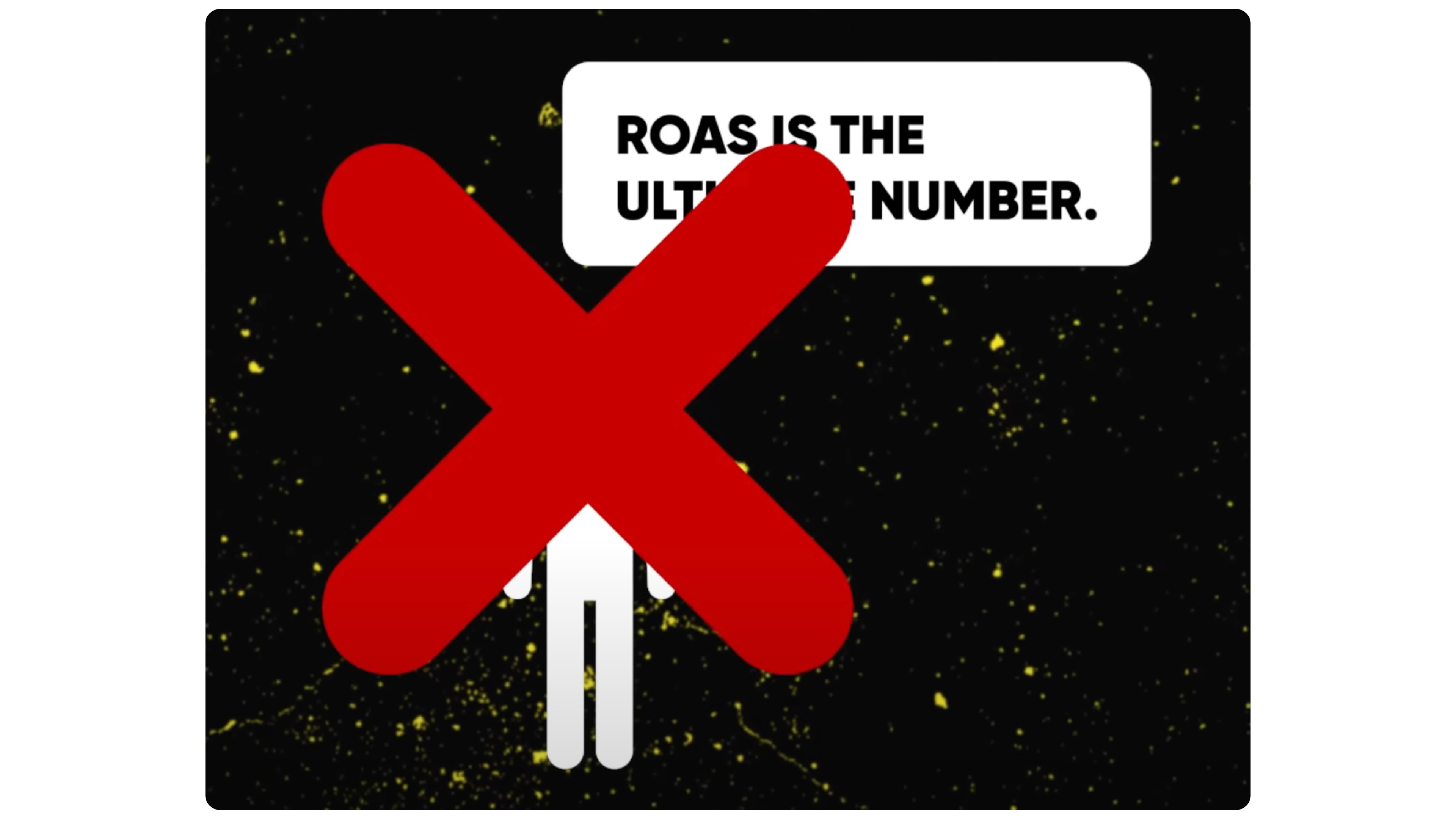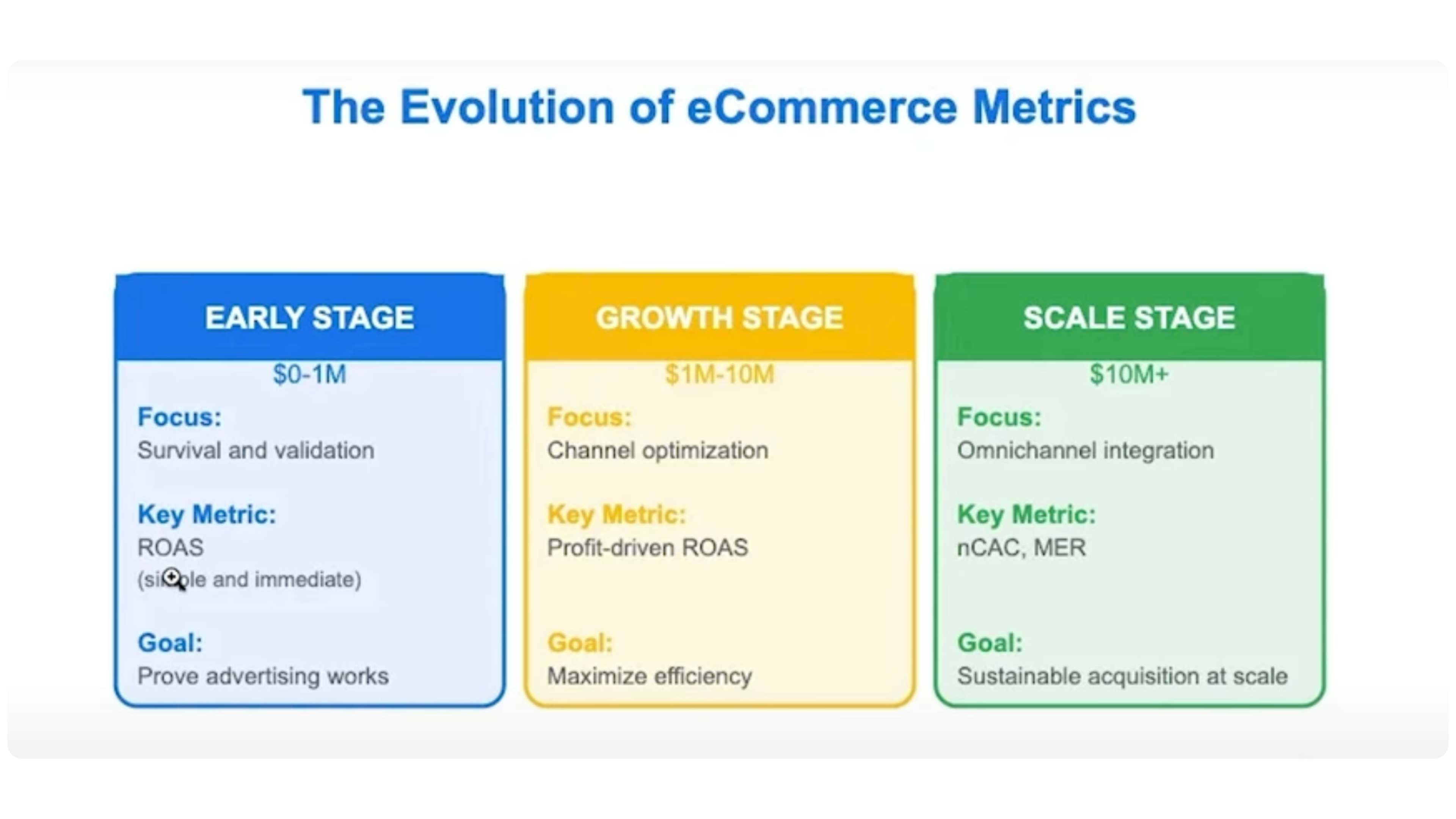If you are an eCommerce store, eventually you are going to hit a ceiling with your ROAS (Return On Ad Spend) targets in your Google Ads account.

At Grow My Ads, we see this happen all the time. You’ve been chasing those high ROAS numbers because everyone said that’s what matters. But here’s the truth:
Your obsession with high ROAS is the exact thing preventing your business from scaling.
In this post, we’ll review why that happens, and how to go beyond ROAS to scale your business sustainably. Prefer video? Check out our video Stop Optimizing for ROAS and EXPLORE GROWTH with This Simple Testing Method:
Still with us? Good, let’s dive in.
The ROAS Trap (And Why Everyone Falls For It)
If you’re running Google Ads for eCommerce, your sales and marketing efforts may be largely built around one metric: ROAS(Return on Ad Spend). Simply put, ROAS is revenue generated from ads divided by advertising spend. So, if you spend $1,000 and make $4,000, that’s a 400% ROAS.
ROAS has its uses. It:
- Is easy to understand (and track)
- Provides a clear benchmark for campaign performance
- Directly ties ad spend to revenue
- Helps maintain profitability guardrails (and informs your advertising budget)
This looks good on paper, but here’s what nobody tells you about those high ROAS numbers:
Much of that revenue comes from warm audiences who would have bought anyway.

At Grow My Ads, we’ve consulted with several businesses who were stuck on a specific ROAS target (like 500%) and couldn’t figure out why their ad campaigns wouldn’t scale beyond a certain spend. They’d try increasing budgets, but Google would never spend the full amount.
Sound familiar?
Why You Hit a Ceiling (Hint: It’s Math)
Here’s what’s happening behind the scenes in your advertising campaigns:
When you tell Google’s algorithm to maintain a specific ROAS target, you’re essentially saying: “Only show my ads to people extremely likely to convert right now.”

This creates an invisible ceiling on your ad campaign because:
- You’re restricting yourself to the tiniest audience pool (high-intent buyers and easy conversions only)
- You’re training Google’s algorithm to avoid new audience discovery
- You’re missing out on new customer acquisition opportunities
The result? Customer acquisition costs may be down, but at a massive cost to your business.
A Simple Testing Framework
Want to know if you’re leaving money on the table? Here’s what works with our clients:
Step 1: Know Your (Actual) Numbers

As an eCommerce business running Google Ads, knowing your margins is critical.
To get started, calculate:
- Your true profit margin percentage
- Your break-even ROAS (100 ÷ your profit margin)
- Your current profit from each campaign
Step 2: Find Your Profit Peak

Next, find the sweet spot for maximum profit and volume. Every business has a different optimal point based on their margins and market, but consider these benchmarks:
- Too high ROAS = Not enough volume
- Too low ROAS = Not enough efficiency
- Optimal point = Maximum total profit
Step 3: Test Lower ROAS Targets

To calculate customer acquisition cost in a way that’s sustainable (and tailored to your business), you’ll need to test. Here’s a simplified 4-week testing framework:
- Week 1: Establish your baseline
- Document current marketing and sales costs, ROAS, profit, customer lifetime value, and new customer rate
- Document current marketing and sales costs, ROAS, profit, customer lifetime value, and new customer rate
- Week 2-3: Test lower targets
- Reduce ROAS targets by 10-15%
- Don’t panic when ROAS drops (that’s the point!)
- Reduce ROAS targets by 10-15%
- Don’t panic when ROAS drops (that’s the point!)
- Week 4: Measure impact
- Track total profit
- Track new customers acquired
- Find your maximum profit point
- Scale (hopefully)
- Track total profit
- Track new customers acquired
- Find your maximum profit point
- Scale (hopefully)
The temporary dip in sales efficiency is worth it if you end up with more total profit and new customers.
What Not to Do: Common Testing Pitfalls to Avoid

When trying to work out your company’s profit peak, here’s what not to do:
- Test too many variables: Changing multiple elements simultaneously makes finding the change that drove results harder.
- Solution: Test one major variable at a time.
- Solution: Test one major variable at a time.
- Insufficient testing duration: Not giving your tests enough time to run results in data inaccuracies.
- Solution: Minimum 30 days per test phase. You need to be able to gut a sufficient testing duration to ensure your marketing efforts are meaningful.
- Solution: Minimum 30 days per test phase. You need to be able to gut a sufficient testing duration to ensure your marketing efforts are meaningful.
- Focusing on the wrong metrics: Stop obsessing over ROAS decreases.
- Solution: Create profit-focused reporting.
- Solution: Create profit-focused reporting.
- Rigid test structure: If you’re following the test plan despite clear negative results, it may be time to rethink.
- Solution: Establish mid-test review points.
- Solution: Establish mid-test review points.
nCAC: The Metric That (Actually) Matters

As your business grows, you’ll want to start thinking about looking beyond ROAS to more nuanced, sophisticated metrics. One of the most powerful is New Customer Acquisition Cost (nCAC).
New Customer Acquisition Cost measures how much you’re paying to acquire a new customer, not just generate a sale from existing customers.
Pair this with Customer Lifetime Value (LTV) and you’ve got the golden ratio that the biggest eCommerce brands use to scale their marketing efforts aggressively.
A 3:1 ratio is a good benchmark to use, so for every $100 you spend to acquire a new customer, they should generate about $300 in customer lifetime value.

This will depend on various factors, including payback period requirements, your growth objectives, and cash position. However, it’s a good place to start as you begin to think about growing your customer base profitably.
Advanced Moves: Segmentation Unlocks Even More Growth
Once you’re thinking in terms of nCAC (New Customer Acquisition Cost) and LTV (Customer Lifetime Value), you can get even more strategic:
- Customer Segmentation LTV Modeling: What if 35-44 year-olds have 2.3x higher LTV (Customer Lifetime Value) than 18-24 year-olds? Your customer acquisition strategies should be different, as you now know you can afford to spend more to acquire the group with a higher LTV.
- Predictive First-Purchase Signals: What if customers who buy Product A have 40% higher LTV (Customer Lifetime Value)? This means you can be more aggressive when bidding on keywords for that product because you know that customer base is worth more.
- Cohort-Based Budget Adjustment: Results can differ across marketing channels. What if Facebook customers are worth more than TikTok customers? Reallocate budget accordingly.
This is how the big players scale while everyone else hits the ceiling.
90-Day Roadmap

Ready to break free from the ROAS trap and optimize your marketing campaigns around more nuanced metrics (like customer acquisition costs and customer lifetime value)? Here’s how to start:
- Phase 1: Preparation (Days 1-14)
- Document your current business metrics, including return on ad spend (ROAS), new customer acquisition costs (nCAC), customer lifetime value (LTV), marketing expenses across marketing channels, customer retention metrics, and more
- Know your margins and break-even ROAS
- Set up proper tracking
- Identify initial test campaigns
- Document your current business metrics, including return on ad spend (ROAS), new customer acquisition costs (nCAC), customer lifetime value (LTV), marketing expenses across marketing channels, customer retention metrics, and more
- Know your margins and break-even ROAS
- Set up proper tracking
- Identify initial test campaigns
- Phase 2: Initial Testing (Days 15-45)
- Implement ROAS ceiling tests on 1-2 campaigns
- Begin tracking total profit impact
- Document all changes and results
- Adjust targets based on initial findings
- Prepare for expanded implementation
- Implement ROAS ceiling tests on 1-2 campaigns
- Begin tracking total profit impact
- Document all changes and results
- Adjust targets based on initial findings
- Prepare for expanded implementation
- Phase 3: Expansion (Days 46-75)
- Roll out optimal ROAS targets to primary campaigns
- Begin tracking customer acquisition metrics
- Implement new customer acquisition cost and customer lifetime value tracking
- Roll out optimal ROAS targets to primary campaigns
- Begin tracking customer acquisition metrics
- Implement new customer acquisition cost and customer lifetime value tracking
- Phase 4: Optimization (Days 76-90)
- Fine-tune campaign-specific targets
- Develop a long-term measurement framework
- Create new reporting dashboards as needed
- Establish ongoing testing protocols
- Fine-tune campaign-specific targets
- Develop a long-term measurement framework
- Create new reporting dashboards as needed
- Establish ongoing testing protocols
The businesses that break free from the ROAS trap gain:
- Growth potential beyond stuck competitors
- Focus on profit and new customers (not vanity metrics artificially bolstered by existing customers)
- Strategic clarity about who their best customers are
- A sustainable advantage from better measurement across current and future advertising campaigns
Stop optimizing for ROAS. Start optimizing for growth. While your competitors continue to chase arbitrary ROAS targets, you’ll be building a more profitable, faster-growing business focused on what truly matters.



